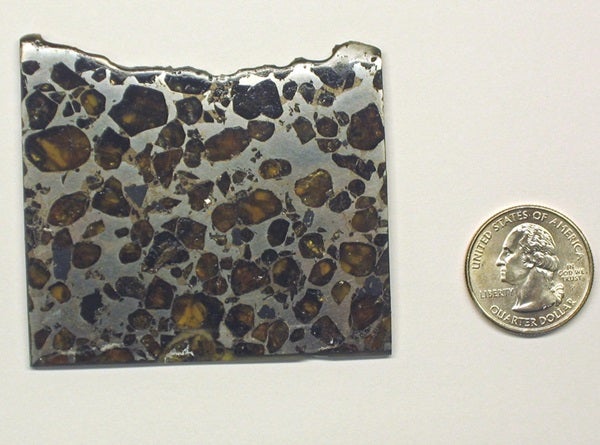An unusual meteorite-hunting expedition reported another in a long string of finds within the Brenham, Kansas, meteorite field. Expedition members unearthed a 1.5-cubic-foot Pallasite weighing 154 pounds (70 kg). Scientists estimate it fell 10,000 years ago.
The Houston Museum of Natural Science organized the expedition. The museum will pay approximately $50,000 for the pallasite, which will be placed in a new exhibit. Meteorite hunters Steve Arnold of Kingston, Arkansas, and Philip Mani of San Antonio, Texas, led the expedition.
Meteorites fall into three general classifications. Stone meteorites have low metal content, originating, as they did, in the outer, stony mantles of asteroids. Iron meteorites are the opposite of stones — they come from asteroids’ metallic cores. Stony-iron meteorites form at the transition zone, which contains both metal and rock.
In space, stony-irons make up about 1 percent of all meteoroids. Likewise, on Earth, about 1 percent of all meteorite finds are stony-irons. Pallasites are one of two classes of stony-iron meteorites. Pallasites have olivine or pyroxene crystals distributed throughout a nickel-iron matrix and are considered the most beautiful of meteorites.
The new pallasite lay 4 feet (1.2 meters) underground and a quarter-mile (400 m) from where Arnold and Mani found a 1,400 pound (636 kg) pallasite in November 2005. That specimen was the largest pallasite ever found in the United States and the second largest in the world.
The expedition used ground-penetrating radar (GPR) developed at Johnson Space Center’s Lunar and Planetary Institute (LPI) in Houston to locate the pallasite. The GPR made an accurate three-dimensional image of the meteorite. The LPI was eager to participate, using this expedition as a proving ground to test whether the GPR could locate meteorites or water on Mars.
Residents found the first fragments of the Brenham pallasite in 1882. Since then, meteorite hunters have recovered more than 15,000 pounds (6,800 kg) of meteorites from the Brenham fall. Arnold and Mani, who lease eight square miles of land from owner Alan Binford, account for more than 30 of the recovered pallasites, which total nearly 5,000 pounds (2,270 kg). By agreement, Arnold, Mani, and Binford split any proceeds from meteorite sales.










